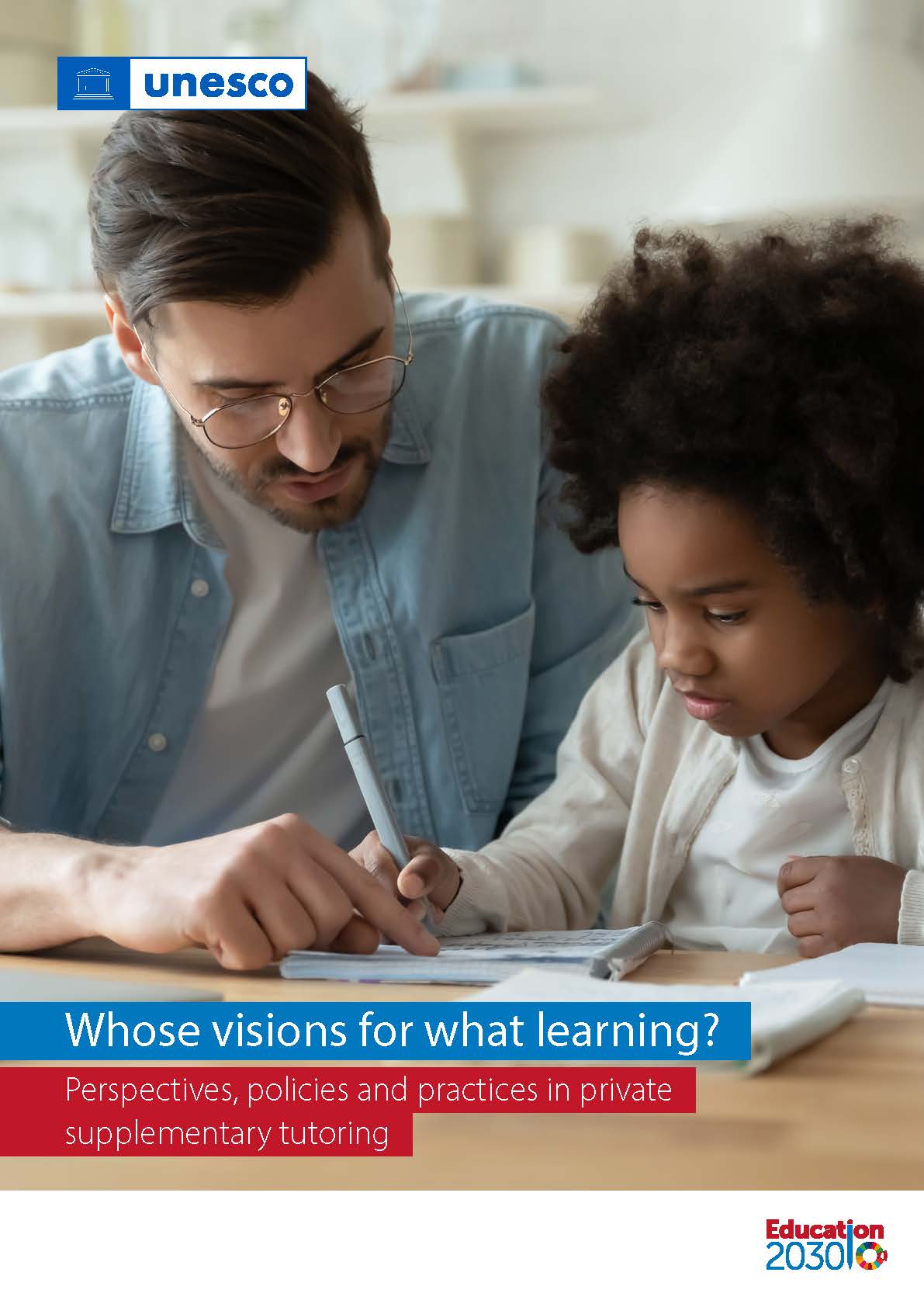Taking Private Tutoring Out of the Shadows
In this blogpost, Mark Bray introduces the UNESCO report Whose visions for what learning? Perspectives, policies and practices in private supplementary tutoring, which emerged from a Policy Forum hosted by UNESCO to discuss how private tutoring affects equity, quality and governance.
In October 2024, UNESCO hosted a Policy Forum entitled Private supplementary tutoring: A multi-stakeholder dialogue for common good. This marked the first time that private supplementary tutoring was given dedicated attention at UNESCO Headquarters. The event built on a longstanding body of research and policy dialogue facilitated by UNESCO, in particular its International Institute for Educational Planning (IIEP), which has examined the growth of private tutoring and its implications for education worldwide.
The Policy Forum brought together diverse voices from across the globe, including those of government policy-makers, tutors, school administrators, teachers, parents, and students. Together, they exchanged perspectives and examined how private tutoring affects education equity, quality and governance.
Following the event, UNESCO published a report entitled Whose visions for what learning? Perspectives, policies and practices in private supplementary tutoring. It provides background analysis and policy considerations on this growing phenomenon.
Why a Shadow?
Private supplementary tutoring is widely described as shadow education because much of its content mimics that in schooling – as the curriculum changes in the schools, so it changes in the shadow. This is a neutral metaphor, though shadow can of course be useful. As remarked in a 1999 book published by UNESCO-IIEP: “Just as the shadow cast by a sun-dial can tell the observer about the passage of time, so the shadow of an education system can tell the observer about change in societies” (Bray, 1999, p. 17).
Alternatively, the metaphor can be used as in the title of this blog. Private tutoring does not receive sufficient public attention, and needs to be taken out of the shadows. In the process, analysts can identify both positive and problematic dimensions. High-quality tutoring that fits pupils’ needs, abilities and aspirations can be very beneficial not only to those pupils and their families but also to the wider societies. Yet much tutoring has poor quality, is a financial burden for households, and exacerbates social inequalities. Private tutoring may also have a complex relationship with schooling, bringing both support and competition.
The Scale of Private Tutoring
The 2025 UNESCO publication commences with dramatic indicators of economic scale (p.12). In 2023, private tutoring had an estimated market size of US$159 billion and was forecasted to reach US$288 billion by 2030 after a compound annual growth rate of 8.8%. Placing these numbers in perspective, in 2023 UNESCO’s Global Education Monitoring Report team estimated the annual financing gap for countries to achieve SDG4 (i.e. fourth of the United Nations’ Sustainable Development Goals, about education) at US$97 billion.
Further indicators of scale are in private tutoring enrolment rates across the globe. Statistics include:
- Chile: In 2019, according to TIMSS data, 23% of Grade 8 students received tutoring in mathematics, and 9% in science.
- Egypt: A 2014 survey of Grade 12 students found 72% receiving private one-to-one tutoring, and 18% receiving private group tutoring (and some presumably receiving both). A 2012 survey had found that even in Grade 1, 33% of students were receiving one-to-one tutoring and 9% were receiving group tutoring.
- Greece: A 2017/18 survey of Grade 12 students found that 70% attended tutorial institutions, 60% received separate personal tutoring (with 40% receiving both), and only 10% received neither.
- England: Data collected in 2022 by the Sutton Trust found that 11% of students aged 11-16 were receiving private tutoring, and that 30% (46% in London) had done so at some time.
- India: National survey data in rural areas found in 2022 that 27% of Grade 1 students were receiving private tutoring, with the proportion reaching 32% in Grade 8. West Bengal had the highest rates, reaching 63% and 76%.
- Mauritius: In 2013, 81% of Grade 6 students were receiving private tutoring.
- Myanmar: A 2017 survey in Yangon found that 83% of Grade 9 and 86% of Grade 11 students were receiving tutoring.
- Republic of Korea: In 2023, 64% of elementary, 66% of middle-school and 56% of high-school students were receiving tutoring.
Forces in Demand
Some families invest in tutoring as a remedial measure to help their children keep up with peers. Many others, however, invest for enrichment. The basic driver in all settings is social competition exacerbated by mobility of labour and the forces of competition.
Parents are also influenced by social norms. When everybody else seems to be investing in tutoring, they may feel pressed to go with the crowd. These parents may view tutoring as a sort of insurance policy to avoid being left behind, even when their children do not really need the tutoring. Yet students may then suffer from double burdens – first of schooling and then of tutoring.
Providers of Tutoring
Three main providers of tutoring may be identified. First are commercial enterprises, operating locally,nationally and/or internationally. Second are teachers who ‘moonlight’ to secure extra incomes alongside their main salaries; and third are informal suppliers ranging from university students to retirees. While some of these tutors have received specialised training, many have not. This brings into question the quality of tutoring.
Other issues related to conflict of interest. When educational services are marketised, providers may prioritise profit over the real needs of their clients. Also, when teachers provide tutoring beyond their regular duties, they may put more effort into the extra work than into their school duties for which they are paid standard salaries.
Particular problems arise when teachers provide extra tutoring to the students who they already teach in school. These teachers may be tempted deliberately to cut content during schooling in order to promote demand for their private services. They may also favour the tutored students during school lessons, discriminating against the others. In some cases, teachers are known to provide answers in advance during tutorial sessions to the examination questions that they will set during the school curriculum.
Regulatory Inadequacies
Many governments have laissez faire approaches to private tutoring. In 2021, UNESCO conducted a global survey to which 205 countries and self-governing jurisdictions responded. Only 24% mentioned educational regulations for tutorial enterprises, and only 26% mentioned regulations on tutoring by serving teachers. The vast majority of governments simply ignored the phenomenon. Some progress has been made since the book entitled Confronting the shadow education system had been published by UNESCO-IIEP in 2009, but more confrontation is needed. Regulations may focus on such matters as tutorial premises, the qualifications of tutors, advertising ethics, clarity in contracts, and safety checks against child abuse.
Yet regulatory matters are not simple. Authorities must consider capacity as well as goals; and as demonstrated by UNESCO’s multi-stakeholder dialogue, the perspectives of different actors may vary considerably. Thus, even parents may not always appreciate government actions that restrict the supply of tutoring either by companies or by teachers.
On the other hand, some tutorial companies welcome regulations that create a more transparent and trustworthy marketplace. In this respect, the Policy Forum particularly appreciated inputs from the Australian Tutoring Association.
Taking the Topic Out of the Shadows
Returning to the title of this blog, private tutoring needs much more attention. It has become a huge sector, demanding considerable household expenditure and with far-reaching implications for students’ learning and well-being, tutors’ employment, family dynamics, and the operations of schooling.
A starting point in most countries is with better data on the scale, nature and impact of tutoring. Beyond that, authorities can encourage dialogue between stakeholders about ways to promote the positive sides of tutoring and limit the negative sides. This can even reach the form of partnerships reflecting UNESCO’s vision for a social contract for common good.
The Author:
Mark Bray is holder of the UNESCO Chair in Comparative Education at the University of Hong Kong. He is author of the report discussed in this blogpost, which was commissioned by UNESCO’s Section of Education Policy. Contact: Mark Bray (mbray@hku.hk) or Huong Le-Thu, UNESCO Section of Education Policy (h.le-thu@unesco.org).


